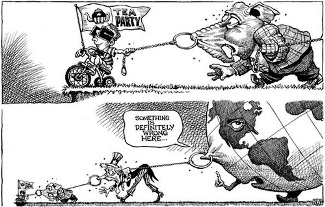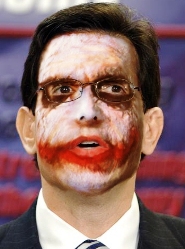
One of the most common tropes in the action-adventure film — particularly the comic actioner — is the car (or train, or bus) that careens toward the cliff/riverbank/unfinished bridge and screeches to a stop just before it’s too late. As the vehicle dangles on the precipice, the passengers scramble out the back to safety, then turn around to contemplate the disaster that might have been. Sometimes their ride home stays put … and sometimes it tumbles into the abyss.
 Teafoxlicans were gambling on that first outcome this summer as they played out their scenario over the debt ceiling, putting the pedal to the metal on the nation’s financial well-being and demanding a ransom in the trillions (spending cuts only!) before they would hit the brakes and avoid a devastating default. Early last week they finally got their deal, left the car teetering on the brink, and climbed out the back, fully expecting that they’d be able to drive home later. Instead, it now seems clear that the car has gone over the cliff — with your 401k and mine inside.
Teafoxlicans were gambling on that first outcome this summer as they played out their scenario over the debt ceiling, putting the pedal to the metal on the nation’s financial well-being and demanding a ransom in the trillions (spending cuts only!) before they would hit the brakes and avoid a devastating default. Early last week they finally got their deal, left the car teetering on the brink, and climbed out the back, fully expecting that they’d be able to drive home later. Instead, it now seems clear that the car has gone over the cliff — with your 401k and mine inside.
Of course, there are other action-pic metaphors I could have chosen — the bitter climax of the atrocious Perfect Storm, perhaps, when the sun comes out briefly but then disappears, and Clooney turns to Wahlberg and grimly intones, ”She’s not gonna let us out.” (Those of us peering into the bleak future might quote John C. Reilly’s so-bad-they’re-horrible final words before being swallowed up by the drink: ”This is gonna be hard on my little boy.”)
Right wingers have lashed out in fury this past week at those who have taken to calling them ”hostage takers” and ”economic terrorists.” Still, to beat the action-flick metaphor just a bit more firmly into the ground, I might suggest that when GOP leaders famously showed their House colleagues a clip from The Town to gird them for the final debt-ceiling battle, they might have been better off showing the climax of The Dark Knight. After all, the Joker’s amoral brilliance in pitting two ferryboats against one another, and daring each to blow up the other before he sends both to oblivion, is a nice metaphor for the Teafoxlicans’ play here: pitting the full faith and credit of the United States against recovery-killing spending cuts.
Sadly, in this case, it seems that both boats have now exploded. But I can guarantee you that Democrats will never stoop to creating Photoshop images that morph John Boehner or Eric Cantor’s face with the Joker’s. That’s not how progressives roll; frankly, we don’t have the balls.
 OK, so I stand corrected. Anyway … and I promise I’m finished with the film references … one can’t help but wish that a middle-of-the-road alternative had been found to this latest fiasco. Imagine that cooler heads had prevailed all the way around, and that in a couple years — after the 2012 election, and after an economist-approved second effort at stimulus that focused on job-creating measures such as infrastructure banks and/or Tom Friedman’s pipe dream of green-tech manufacturing — Democrats and Republicans had agreed to implement a debt-reduction plan modeled on Simpson-Bowles. That plan might have bent the entitlement cost curve via retirement-age adjustments, means testing and an end to caps on payroll taxes, while also bringing spending down from its current historic highs (25 percent of GDP) and taxes up from their current historic lows (just over 15 percent of GDP), to an equivalent share of GDP set at approximately 19 percent. There’s no guarantee that the economy would have sprung back to life under such a scenario — we had all better get used to the likelihood that times will never again be as good, nor the help-wanted listings ever again as voluminous, as they were in the late 1990s — but at least the world’s political and financial systems would have more confidence in our nation’s ability to solve problems than we currently deserve.
OK, so I stand corrected. Anyway … and I promise I’m finished with the film references … one can’t help but wish that a middle-of-the-road alternative had been found to this latest fiasco. Imagine that cooler heads had prevailed all the way around, and that in a couple years — after the 2012 election, and after an economist-approved second effort at stimulus that focused on job-creating measures such as infrastructure banks and/or Tom Friedman’s pipe dream of green-tech manufacturing — Democrats and Republicans had agreed to implement a debt-reduction plan modeled on Simpson-Bowles. That plan might have bent the entitlement cost curve via retirement-age adjustments, means testing and an end to caps on payroll taxes, while also bringing spending down from its current historic highs (25 percent of GDP) and taxes up from their current historic lows (just over 15 percent of GDP), to an equivalent share of GDP set at approximately 19 percent. There’s no guarantee that the economy would have sprung back to life under such a scenario — we had all better get used to the likelihood that times will never again be as good, nor the help-wanted listings ever again as voluminous, as they were in the late 1990s — but at least the world’s political and financial systems would have more confidence in our nation’s ability to solve problems than we currently deserve.
Unfortunately, the politics and the economics of our current fiscal meltdown are nowadays so intertwined that they cannot be analyzed separately, even by Standard & Poor’s or our creditors in China. It has already been documented that the Tea Party Caucus and the House GOP leadership spent at least eight months strategizing how they were going to use brinksmanship on the debt ceiling as a catalyst for their agenda. You would think that in all that time they might have, at some point, entertained the possibility that acting like lunatics right up to the last minute might somehow shake the confidence of both Wall Street and the multitudinous Main Streets in the U.S. and abroad. Apparently not — and instead they did such a bang-up job carrying out their half-assed plan that they’ve exposed themselves as entirely too irrational to participate in governing a country. What’s more — and what’s worse — they’ve managed to convince the markets, our creditors, and at least one rating agency that any government with Teafoxlicans grasping one of the reins of power cannot be trusted to maintain even a minimum baseline of economic stability. Even Newt Gingrich’s Republican Revolutionaries didn’t screw the pooch this badly, or this quickly in their brief reign of (t)error.
It didn’t have to be this way. There has rightfully been a lot of discussion the last few weeks about the lost art of compromise, in the wake of the Tea Partiers’ utter recalcitrance in refusing a ”grand bargain” on debt reduction. They had the opportunity, weeks before the deadline was reached, to accept a deal that would have enacted big spending cuts, and even instituted entitlement reform, in exchange for a minimal amount in ”revenue enhancements” — i.e., tax hikes on the rich, or even (eventually, as Democrats did their best to negotiate away the store) merely a few loophole closures. They might have been able to portray themselves as shrewd bargainers who took a very small hit to their own anti-tax ”values” in order to achieve a major push forward for their agenda, all while keeping the markets calm and our creditors happy.
 But, of course, the House GOP blew it. They had to hew to their no-new-taxes orthodoxy, and they had to drive all the way to the edge of that cliff to see how much booty they could extort before they slammed on the brakes. And what did they wind up with? A smaller deal than they could have gotten otherwise, a ”super-committee” with practically no chance of success, and a ”trigger” mechanism likely to blow gaping, and indiscriminate, holes in both the entitlement and defense budgets. Not to mention a resounding no-confidence vote from Wall Street and the Chinese that seems to have put us right back where we were in September 2008, with hundreds of billions of dollars of lost wealth in the marketplace and millions more Americans losing job opportunities, postponing retirements yet again, or otherwise being forced once more to adjust their standards of living downward.
But, of course, the House GOP blew it. They had to hew to their no-new-taxes orthodoxy, and they had to drive all the way to the edge of that cliff to see how much booty they could extort before they slammed on the brakes. And what did they wind up with? A smaller deal than they could have gotten otherwise, a ”super-committee” with practically no chance of success, and a ”trigger” mechanism likely to blow gaping, and indiscriminate, holes in both the entitlement and defense budgets. Not to mention a resounding no-confidence vote from Wall Street and the Chinese that seems to have put us right back where we were in September 2008, with hundreds of billions of dollars of lost wealth in the marketplace and millions more Americans losing job opportunities, postponing retirements yet again, or otherwise being forced once more to adjust their standards of living downward.
But this time, of course, there will be no attempt to stimulate the economy from Washington. Another key element of Teafoxlican orthodoxy holds that the half-hearted, nearly half-tax-cuts 2009 stimulus ”didn’t work,” and that job-creating investments in infrastructure, clean-energy manufacturing, or new technologies represent foolish attempts to ”spend our way out of recession.” Government must be shrunk further and further, the ”thinking” goes, no matter what the circumstances or the impact on the broader economy. Never mind the historical precedent of 1937, when a contraction of government spending turned a recovery into a double-dip depression. And never mind the opinion shared by every smart economist that now is the time for government to fill the role abdicated by a business community that simply will not hire, not to pull the rug (or, rather, the safety net) out from under tens of millions who are in danger of falling into poverty if they have not already done so. That argument is rarely heard anymore, consumed in a conflagration of Teafoxlican harping on debts and deficits.
That harping represents their one clear success — their ability to transform the political narrative from what it should be (a slow-but-steady effort to clean up the financial and political messes of the last decade, and make sure they won’t be repeated) to what they want it to be (an endless rant about debts that supposedly have only spiraled out of control over the past 2½ years). The right wing have moved the entire conversation in their desired direction, thanks in part to the loudness of their voices and in part to the fact that they, and they alone, were willing to put a gun to the nation’s head and threaten to shoot.
 Please note that nowhere in the above sentence did I write ”because they have a point.” They don’t. Yes, deficits will need to be brought under control eventually, and yes, both discretionary spending cuts and entitlement reform (along with tax increases) are absolutely necessary to put our financial house in order. But putting a stopper on government spending shouldn’t have happened now, in the midst of a continuing recession marked by a singular unwillingness of the nation’s businesses to contribute to recovery. And deficit reduction should never have been attached to a game of Russian Roulette with the debt ceiling.
Please note that nowhere in the above sentence did I write ”because they have a point.” They don’t. Yes, deficits will need to be brought under control eventually, and yes, both discretionary spending cuts and entitlement reform (along with tax increases) are absolutely necessary to put our financial house in order. But putting a stopper on government spending shouldn’t have happened now, in the midst of a continuing recession marked by a singular unwillingness of the nation’s businesses to contribute to recovery. And deficit reduction should never have been attached to a game of Russian Roulette with the debt ceiling.
The refusal to make these points, and to fight valiantly for some measure of sanity over the last seven months, is the signature failure of Barack Obama’s presidency. On Sunday the author and psych professor Drew Weston detailed, in a brilliant New York Times op-ed, the ways in which Obama — who had been, up until the day before his inauguration, the new century’s greatest orator — failed to use his prodigious skills to create a narrative for his presidency that might have withstood the Teafoxlican revolt. By identifying (early and specifically) the sources of the nation’s troubles, by describing how he was going to act to bring those responsible to account and how he was going to repair our broken financial and political systems — and then by making every one of his initiatives (healthcare included) fit within that narrative — Obama could, and should, have driven the public dialogue the way Ronald Reagan did, no matter how effective the Gipper’s zig-zagging policies turned out to be.
Instead, Obama has turned too much policy-making over to the congressional sausage-grinder, and his far-too-frequent abdication of the bully pulpit has allowed right-wing nutjobs to fill the vacuum created by his silence. Too often, as well, he has pursued bipartisanship in the face of unrelenting evidence that he had no partner in his efforts at conciliation — most recently in his willingness to give up tax hikes far too early in the debt-ceiling negotiations, and in his unwillingness to use the 14th amendment to defuse the Teafoxlicans’ threats to plunge the nation into default.
 While watching Obama give away entirely too much of the store in recent months, I have often thought of the deal Jackie Robinson cut with Branch Rickey back in 1945: Robinson would turn the other cheek in the face of insults and intolerance for three seasons in the majors, but would be turned loose to fight back and retaliate after that. Is it possible, now that this utter disaster has exposed the Teafoxlicans’ inability to participate rationally in our governance, that Obama will finally take off the kid gloves and destroy them rhetorically the way he should have two summers ago? Will he now, at long last, grab the reins of leadership fully and finally from a Congress that is universally distrusted and clearly at its wit’s end? Is Obama even capable of being that kind of guy? Does he want to be?
While watching Obama give away entirely too much of the store in recent months, I have often thought of the deal Jackie Robinson cut with Branch Rickey back in 1945: Robinson would turn the other cheek in the face of insults and intolerance for three seasons in the majors, but would be turned loose to fight back and retaliate after that. Is it possible, now that this utter disaster has exposed the Teafoxlicans’ inability to participate rationally in our governance, that Obama will finally take off the kid gloves and destroy them rhetorically the way he should have two summers ago? Will he now, at long last, grab the reins of leadership fully and finally from a Congress that is universally distrusted and clearly at its wit’s end? Is Obama even capable of being that kind of guy? Does he want to be?
If not, we need to find a leader who does. And here’s where I break my earlier promise, and conclude with one more film reference — paraphrasing a line delivered repeatedly by Dan Hedaya’s character in the lackluster Tom Hanks/Meg Ryan vehicle Joe Versus the Volcano. We know Obama was impressive enough to get the job. We know he’ll probably be able to keep the job. But can he do the job? The jury’s still out on that one, and unless he proves himself up to the task of truly seizing control of this mess, America may still have a way to go before we hit bottom.




Comments